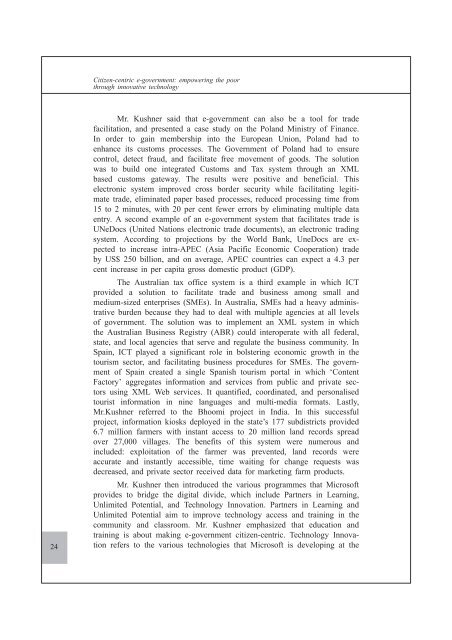Designing e-Government for the Poor - Tanzania Development ...
Designing e-Government for the Poor - Tanzania Development ...
Designing e-Government for the Poor - Tanzania Development ...
You also want an ePaper? Increase the reach of your titles
YUMPU automatically turns print PDFs into web optimized ePapers that Google loves.
24<br />
Citizen-centric e-government: empowering <strong>the</strong> poor<br />
through innovative technology<br />
Mr. Kushner said that e-government can also be a tool <strong>for</strong> trade<br />
facilitation, and presented a case study on <strong>the</strong> Poland Ministry of Finance.<br />
In order to gain membership into <strong>the</strong> European Union, Poland had to<br />
enhance its customs processes. The <strong>Government</strong> of Poland had to ensure<br />
control, detect fraud, and facilitate free movement of goods. The solution<br />
was to build one integrated Customs and Tax system through an XML<br />
based customs gateway. The results were positive and beneficial. This<br />
electronic system improved cross border security while facilitating legitimate<br />
trade, eliminated paper based processes, reduced processing time from<br />
15 to 2 minutes, with 20 per cent fewer errors by eliminating multiple data<br />
entry. A second example of an e-government system that facilitates trade is<br />
UNeDocs (United Nations electronic trade documents), an electronic trading<br />
system. According to projections by <strong>the</strong> World Bank, UneDocs are expected<br />
to increase intra-APEC (Asia Pacific Economic Cooperation) trade<br />
by US$ 250 billion, and on average, APEC countries can expect a 4.3 per<br />
cent increase in per capita gross domestic product (GDP).<br />
The Australian tax office system is a third example in which ICT<br />
provided a solution to facilitate trade and business among small and<br />
medium-sized enterprises (SMEs). In Australia, SMEs had a heavy administrative<br />
burden because <strong>the</strong>y had to deal with multiple agencies at all levels<br />
of government. The solution was to implement an XML system in which<br />
<strong>the</strong> Australian Business Registry (ABR) could interoperate with all federal,<br />
state, and local agencies that serve and regulate <strong>the</strong> business community. In<br />
Spain, ICT played a significant role in bolstering economic growth in <strong>the</strong><br />
tourism sector, and facilitating business procedures <strong>for</strong> SMEs. The government<br />
of Spain created a single Spanish tourism portal in which ‘Content<br />
Factory’ aggregates in<strong>for</strong>mation and services from public and private sectors<br />
using XML Web services. It quantified, coordinated, and personalised<br />
tourist in<strong>for</strong>mation in nine languages and multi-media <strong>for</strong>mats. Lastly,<br />
Mr.Kushner referred to <strong>the</strong> Bhoomi project in India. In this successful<br />
project, in<strong>for</strong>mation kiosks deployed in <strong>the</strong> state’s 177 subdistricts provided<br />
6.7 million farmers with instant access to 20 million land records spread<br />
over 27,000 villages. The benefits of this system were numerous and<br />
included: exploitation of <strong>the</strong> farmer was prevented, land records were<br />
accurate and instantly accessible, time waiting <strong>for</strong> change requests was<br />
decreased, and private sector received data <strong>for</strong> marketing farm products.<br />
Mr. Kushner <strong>the</strong>n introduced <strong>the</strong> various programmes that Microsoft<br />
provides to bridge <strong>the</strong> digital divide, which include Partners in Learning,<br />
Unlimited Potential, and Technology Innovation. Partners in Learning and<br />
Unlimited Potential aim to improve technology access and training in <strong>the</strong><br />
community and classroom. Mr. Kushner emphasized that education and<br />
training is about making e-government citizen-centric. Technology Innovation<br />
refers to <strong>the</strong> various technologies that Microsoft is developing at <strong>the</strong>

















